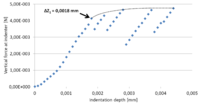Michael Szelwis: "Particle-reinforced composites simulated by cohesive discrete elements"
Abstract
Interest in the simulation of material properties using numerical methods is increasing, as laboratory experiments and tests are often expensive and generally limited in flexibility. In this work, a DEM-approach is presented which simulates the elastic-plastic behavior of particle reinforced composites. While in the past, Discrete Element Modeling (DEM) has successfully been used to simulate elasticity and brittleness of materials, this modified approach based on the principals of Molecular Dynamics suggests a DEM-approach for modeling plastic materials. Simulations of a ceramic-polymer composite (TiO2-particles in a matrix PMMA) subjected to varying load conditions are presented. While Hertz-Mindlin forces are inherent in the algorithm, two variants of modeling particle attraction, particle bonds and cohesion, are applied individually. According to the results of this work, the new cohesive DEM is in good qualitative agreement with the behavior of particle-reinforced composites and therefore preferred. Ideas are presented for a modification of the computer algorithm to calibrate this cohesive DEM approach, aiming at an effective numerical method which can support experimental research on particle-reinforced composites.
Complete Article
Медиа:CohesiveDEM_DA_MSzelwis_Dez2011.pdf


